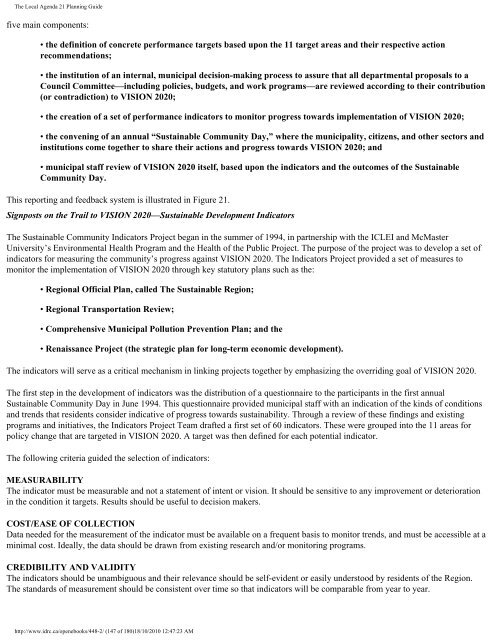The Local Agenda 21 Planning Guide - Democrats Against UN ...
The Local Agenda 21 Planning Guide - Democrats Against UN ...
The Local Agenda 21 Planning Guide - Democrats Against UN ...
You also want an ePaper? Increase the reach of your titles
YUMPU automatically turns print PDFs into web optimized ePapers that Google loves.
<strong>The</strong> <strong>Local</strong> <strong>Agenda</strong> <strong>21</strong> <strong>Planning</strong> <strong>Guide</strong><br />
five main components:<br />
• the definition of concrete performance targets based upon the 11 target areas and their respective action<br />
recommendations;<br />
• the institution of an internal, municipal decision-making process to assure that all departmental proposals to a<br />
Council Committee—including policies, budgets, and work programs—are reviewed according to their contribution<br />
(or contradiction) to VISION 2020;<br />
• the creation of a set of performance indicators to monitor progress towards implementation of VISION 2020;<br />
• the convening of an annual “Sustainable Community Day,” where the municipality, citizens, and other sectors and<br />
institutions come together to share their actions and progress towards VISION 2020; and<br />
• municipal staff review of VISION 2020 itself, based upon the indicators and the outcomes of the Sustainable<br />
Community Day.<br />
This reporting and feedback system is illustrated in Figure <strong>21</strong>.<br />
Signposts on the Trail to VISION 2020—Sustainable Development Indicators<br />
<strong>The</strong> Sustainable Community Indicators Project began in the summer of 1994, in partnership with the ICLEI and McMaster<br />
University’s Environmental Health Program and the Health of the Public Project. <strong>The</strong> purpose of the project was to develop a set of<br />
indicators for measuring the community’s progress against VISION 2020. <strong>The</strong> Indicators Project provided a set of measures to<br />
monitor the implementation of VISION 2020 through key statutory plans such as the:<br />
• Regional Official Plan, called <strong>The</strong> Sustainable Region;<br />
• Regional Transportation Review;<br />
• Comprehensive Municipal Pollution Prevention Plan; and the<br />
• Renaissance Project (the strategic plan for long-term economic development).<br />
<strong>The</strong> indicators will serve as a critical mechanism in linking projects together by emphasizing the overriding goal of VISION 2020.<br />
<strong>The</strong> first step in the development of indicators was the distribution of a questionnaire to the participants in the first annual<br />
Sustainable Community Day in June 1994. This questionnaire provided municipal staff with an indication of the kinds of conditions<br />
and trends that residents consider indicative of progress towards sustainability. Through a review of these findings and existing<br />
programs and initiatives, the Indicators Project Team drafted a first set of 60 indicators. <strong>The</strong>se were grouped into the 11 areas for<br />
policy change that are targeted in VISION 2020. A target was then defined for each potential indicator.<br />
<strong>The</strong> following criteria guided the selection of indicators:<br />
MEASURABILITY<br />
<strong>The</strong> indicator must be measurable and not a statement of intent or vision. It should be sensitive to any improvement or deterioration<br />
in the condition it targets. Results should be useful to decision makers.<br />
COST/EASE OF COLLECTION<br />
Data needed for the measurement of the indicator must be available on a frequent basis to monitor trends, and must be accessible at a<br />
minimal cost. Ideally, the data should be drawn from existing research and/or monitoring programs.<br />
CREDIBILITY AND VALIDITY<br />
<strong>The</strong> indicators should be unambiguous and their relevance should be self-evident or easily understood by residents of the Region.<br />
<strong>The</strong> standards of measurement should be consistent over time so that indicators will be comparable from year to year.<br />
http://www.idrc.ca/openebooks/448-2/ (147 of 180)18/10/2010 12:47:23 AM










